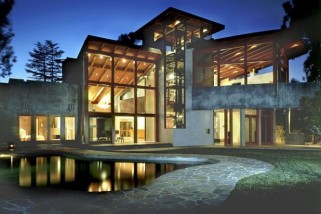Solid wood flooring can be expensive and comes with many drawbacks such as a lack of flexibility in humid conditions. But when you choose engineered wood, you get a stylish product with many advantages.
It makes the best use of natural resources and it’s just perfect for any room in your home.
1. Hard-Wearing
Engineered wood is manufactured from multiple layers of timber. The lower planks are usually of less decorative wood such as pine. They can even be made from economical, ecological, recycled timber by-products or fibreboard. Several thin layers with a density similar to plywood are glued together. Then the top layer of real oak or a similar wood is applied to the surface. It’s this layered effect that gives engineered wood amazing flexibility and additional resistance to excessive footfall compared to a solid wood floor. It means your flooring can withstand the rigours of family life for many years to come. And providing you remember to give it a little attention every so often, it should still look as delightful as the day it was installed.
2. Economical
Unlike its solid timber rival, engineered wood flooring is a cost-effective option. It only uses a thin top layer of attractive timber such as maple, beech or oak. This drastically reduces the expense of the timbers used for your floor despite the longer manufacturing process. The investment you make in choosing engineered wood flooring should be recouped when you balance out the expense of inferior materials. Vinyl and laminates are far less robust and only last for a fraction of the time. They’ll need replacing every ten years or so. On balance, the durability of engineered wood flooring makes it an ideal choice for your home against cheaper forms of flooring.
3. Fast Installation
The manufacturing techniques to produce the timbers for engineered wood flooring incorporate all your installers need to make the job mercifully quick. Each plank includes shaping along each side for tongue and groove connection. It makes each plank simple to fit the next and produces a beautifully smooth surface that’s fixed firmly in place. Cutting each plank to correspond with the dimensions of your room is easier with engineered wood than with solid timber. It means your installers won’t have to work so long to complete the flooring. This helps with reducing the cost of installation. It gives you the chance to have your floor looking and performing perfectly due to a professional installation. But if you’re super confident, you can always opt for DIY.
4. Long-Lasting
When you provide your home with flooring made of engineered wood, you know it will last for ages. Depending on how you treat it, you can expect to get an average of more than thirty years of trouble-free service. In some cases, it could even last for much more, which is comparable with some of the finest solid wood floors.
Over the decades, your floor is sure to collect a few scuff marks, notches and scratches. But most engineered wood floors have a top layer of solid wood that’s thick enough to withstand resurfacing every twenty years or so. The surface timber should measure around 5 millimetres thick to be sure of successfully re-sanding. Then all it needs is an application of wood stain to make your floor look as good as new.
5. Easy Maintenance
One of the greatest advantages of engineered wood flooring is the easy maintenance. It only needs regular sessions of vacuuming or sweeping with a soft bristle broom to keep it dirt and dust-free. There will inevitably be times when someone treads in mud or drops something that sticks, but a quick mopping should soon restore your floor’s good looks.
However, always sweep up debris first to prevent scratching the surface when you mop. Engineered wood flooring is extremely moisture resistant, making it an ideal choice for kitchens and bathrooms. But it doesn’t perform well when soaked. Always mop up spillages as quickly as possible. And for best results when cleaning with a mop, always wring it out until it’s almost dry.
6. Choice of Designs
The wide range of patterns for engineered wood flooring, along with different finishes and colours, gives you the chance to make your home look unique. The way the timbers are laid can even produce optical illusions to enhance any room. A small room can appear lengthened if you choose the simple long-plank pattern. This is one of the oldest designs where the timbers lie side by side. The opposite is the Versailles Panel. This intricately woven pattern evolved in seventeenth-century France. It looks very effective in an uncluttered room. Somewhere between the two is the Chevron and the Herringbone. These two designs feature a zigzag effect that’s attractive and practical for any room. The only difference is Chevron has sharp points where the timbers join, whereas Herringbone is straight cut.
7. Sustainability
We’re all anxious to preserve the world’s dwindling forests. But engineered wood flooring uses a fraction of the timber used in solid wood floors. The type of timber you choose can make an impact on natural resources too. The Australian Responsible Wood Organisation has plenty of information on the best timbers you should choose. Timber should be authentically certified as being sourced from managed woodlands. The production techniques of plastic flooring such as vinyl and laminates involve harmful by-products and Volatile Organic Compounds. Engineered wood takes much less time and energy to manufacture. And any residue can be used for other products. Engineered wood flooring is a sustainable design element using natural material that can be replenished at the source. At the end of its life, it can easily be recycled or upcycled to save on waste.
Conclusion
The benefits of choosing engineered wood flooring are clear. You get an amazing floor with patterns that look incredible, and it can withstand family use for a lifetime. It’s energy-saving on the manufacturing side and for yourself, engineered wood is easy to look after and clean. Engineered wood flooring is an ecological choice that’s an affordable, long-term investment.
- Top-Five Farm Gate Signs Ideas - August 17, 2022
- 7 Benefits of Engineered Wood Flooring - January 27, 2022
- How Smart Homes are Impacting the Interior Design Industry - January 10, 2022











